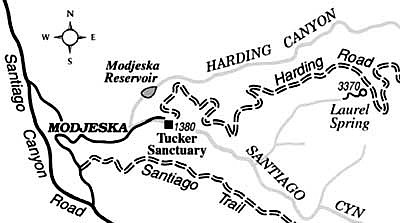 Facebook
Facebook
 X
X
 Instagram
Instagram
 TikTok
TikTok
 Youtube
Youtube
Laurel Spring, a mini-oasis tucked into an upper crease of the Santa Ana Mountains, lies just three air miles away from the expanding edge of Orange County's outer suburbs. Groundwater coming to the surface here nourishes a dense thicket of California bay (a.k.a. bay laurel) trees. Under this arboreal canopy, you can enjoy a cool breeze scented with the pungent odor of bay-leaf spice.
The five-mile-long walk up to the spring is enhanced -- for the next couple of months, at any rate -- by blooming sage-scrub and chaparral vegetation. By early spring, blue-flowering ceanothus and Matilija poppies should put on a great show.
To reach the trailhead, follow Santiago Canyon Road east and north from El Toro, or south from Orange, to either Modjeska Canyon Road or Modjeska Grade Road. Both roads lead quickly to the rustic canyon community of Modjeska, named after the famed 19th-century Shakespearean actress Helena Modjeska, whose 400-acre "Forest of Arden" retreat was located here.
From Modjeska, continue east on a narrowing road to Tucker Wildlife Sanctuary, a Cal State Fullerton biological study area. Parking is scarce; find a spot wherever parking is allowed. Across from the Tucker Sanctuary, the gated fire road signed 5S08 Harding Road begins curling up a hillside. Heading up this road on foot or by mountain bike, you soon pass into Cleveland National Forest land.
At a road fork in 0.4 mile, stay right; the left road goes down to the off-limits Modjeska Reservoir in Harding Canyon. At 0.7 mile a ridgetop clearing next to a hairpin turn provides a view straight up the tree-choked bottom of Harding Canyon. The upper section of this seemingly impenetrable canyon was the scene of a short-lived lead and silver mining boom beginning in 1878. For a while miners swarmed so thickly throughout the canyon that, according to a newspaper account of the day, a man could hardly swing a pick without "perforating his neighbor."
At 1.6 miles you'll pass a wooden structure known as the "goat shed" where you get a good vista of Modjeska Canyon and Santiago Canyon to the south. You continue curling inexorably uphill, generally east, on or near the ridgeline dividing Harding and Santiago Canyons.
At 4.9 miles a large landslide lies on the left. Just beyond, the road bends around the head of a ravine densely choked with bay laurel. On the right, look for the steep, narrow pathway that leads down about 50 vertical feet to Laurel Spring. A concrete watering trough collects water from the spring, good for horses and dogs, but not for humans.


Laurel Spring, a mini-oasis tucked into an upper crease of the Santa Ana Mountains, lies just three air miles away from the expanding edge of Orange County's outer suburbs. Groundwater coming to the surface here nourishes a dense thicket of California bay (a.k.a. bay laurel) trees. Under this arboreal canopy, you can enjoy a cool breeze scented with the pungent odor of bay-leaf spice.
The five-mile-long walk up to the spring is enhanced -- for the next couple of months, at any rate -- by blooming sage-scrub and chaparral vegetation. By early spring, blue-flowering ceanothus and Matilija poppies should put on a great show.
To reach the trailhead, follow Santiago Canyon Road east and north from El Toro, or south from Orange, to either Modjeska Canyon Road or Modjeska Grade Road. Both roads lead quickly to the rustic canyon community of Modjeska, named after the famed 19th-century Shakespearean actress Helena Modjeska, whose 400-acre "Forest of Arden" retreat was located here.
From Modjeska, continue east on a narrowing road to Tucker Wildlife Sanctuary, a Cal State Fullerton biological study area. Parking is scarce; find a spot wherever parking is allowed. Across from the Tucker Sanctuary, the gated fire road signed 5S08 Harding Road begins curling up a hillside. Heading up this road on foot or by mountain bike, you soon pass into Cleveland National Forest land.
At a road fork in 0.4 mile, stay right; the left road goes down to the off-limits Modjeska Reservoir in Harding Canyon. At 0.7 mile a ridgetop clearing next to a hairpin turn provides a view straight up the tree-choked bottom of Harding Canyon. The upper section of this seemingly impenetrable canyon was the scene of a short-lived lead and silver mining boom beginning in 1878. For a while miners swarmed so thickly throughout the canyon that, according to a newspaper account of the day, a man could hardly swing a pick without "perforating his neighbor."
At 1.6 miles you'll pass a wooden structure known as the "goat shed" where you get a good vista of Modjeska Canyon and Santiago Canyon to the south. You continue curling inexorably uphill, generally east, on or near the ridgeline dividing Harding and Santiago Canyons.
At 4.9 miles a large landslide lies on the left. Just beyond, the road bends around the head of a ravine densely choked with bay laurel. On the right, look for the steep, narrow pathway that leads down about 50 vertical feet to Laurel Spring. A concrete watering trough collects water from the spring, good for horses and dogs, but not for humans.
